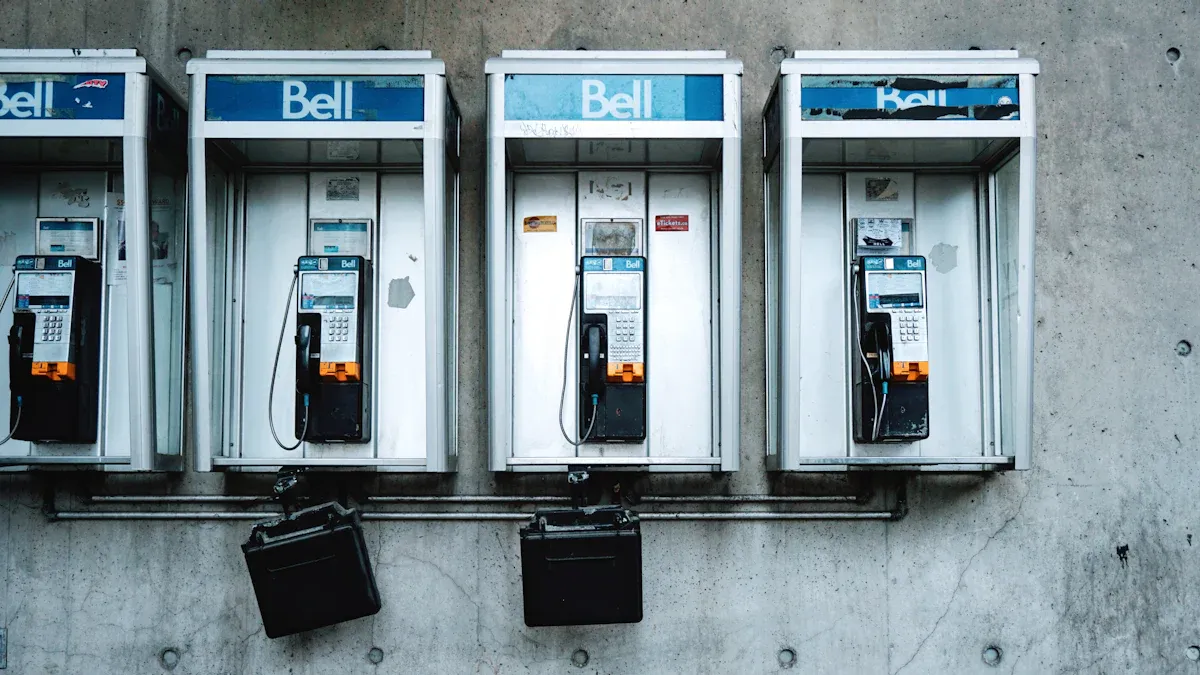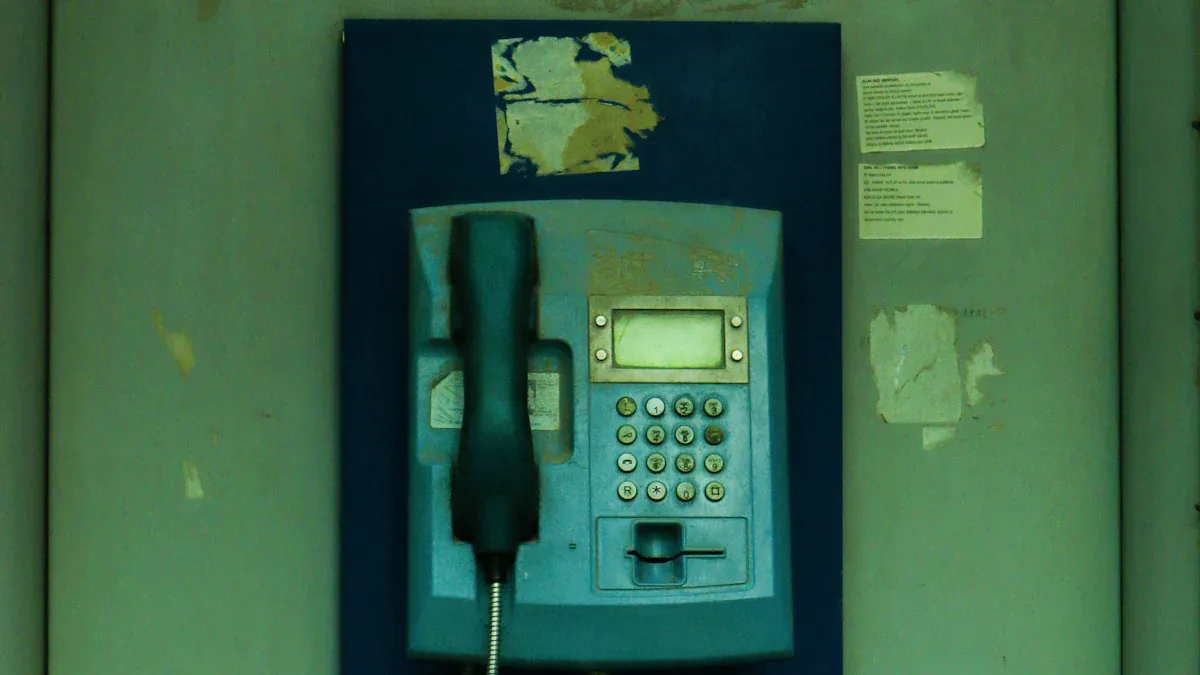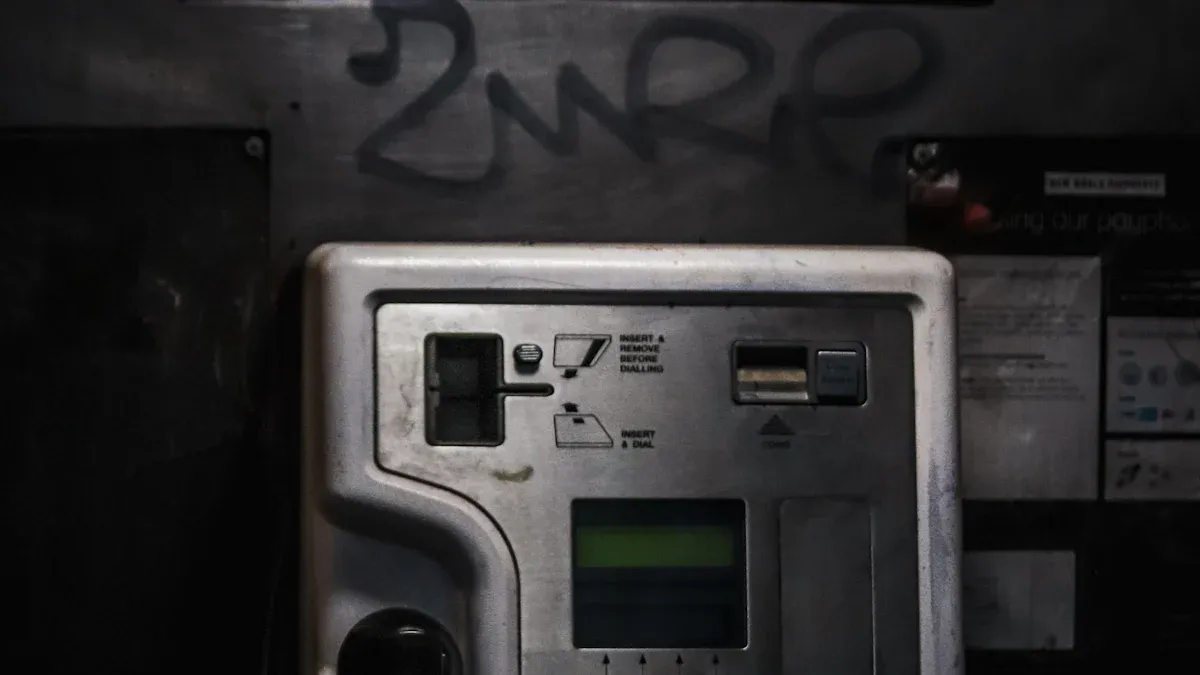
Metal-enclosed keypads, specifically the keypad with metal enclosure, have transformed public payphones into durable and reliable tools for communication. You may not realize it, but these keypads were designed to endure constant use in busy city streets and harsh weather conditions. Their sturdy construction allowed payphones to thrive in environments where weaker materials would fail.
Manufacturers, including metal keypad manufacturers in China, perfected the design of the china keypad with metal enclosure to address challenges like vandalism and tampering. By prioritizing durability and security, these manufacturers helped create a public infrastructure that connected millions of people, fostering urban connectivity.
Key Takeaways
- Metal keypads made payphones strong and able to last long.
- These keypads stopped damage from vandalism and bad weather, saving repairs.
- Big buttons and touchable parts helped everyone, even visually impaired users.
- Payphones became symbols of city life and old memories. Their design inspired ATMs and smartphones.
- Turning old payphones into Wi-Fi spots shows their usefulness and tough design.
The Evolution of Payphones and Keypad Design

Early Payphone Challenges
When payphones first appeared, they faced many challenges that made their widespread use difficult. Early models relied on rotary dials, which were slow and prone to mechanical failure. You might imagine how frustrating it was for users to deal with stuck dials or misdialed numbers. These payphones also lacked durability. Materials like plastic and lightweight metals couldn’t withstand the wear and tear of public use.
Vandalism became another major issue. People often tampered with payphones, damaging their components or stealing coins. In addition, exposure to rain, snow, and extreme temperatures caused these devices to malfunction. Without proper protection, payphones struggled to remain operational in outdoor environments. These challenges highlighted the need for a more robust design that could handle both human interference and environmental stress.
Transition to Metal-Enclosed Keypads
The introduction of the keypad with metal enclosure marked a turning point in payphone design. This innovation replaced fragile rotary dials with a more reliable and user-friendly interface. You no longer had to wait for a dial to spin back into place; instead, you could press buttons to quickly input numbers.
The metal enclosure added a layer of protection that earlier designs lacked. Manufacturers chose materials like stainless steel for their strength and resistance to corrosion. This change ensured that payphones could endure heavy use in busy urban areas. The keypad with metal enclosure also simplified maintenance. Technicians could easily replace damaged buttons without overhauling the entire system. This practical design helped payphones become a dependable part of public infrastructure.
Addressing Vandalism and Environmental Factors
Vandalism and harsh weather conditions posed significant threats to payphones. The metal-enclosed keypad directly addressed these issues. Its sturdy construction made it difficult for vandals to tamper with or destroy the buttons. You might notice that even today, older payphones with metal keypads often show fewer signs of damage compared to their plastic counterparts.
The enclosure also protected the internal components from water, dirt, and extreme temperatures. This feature allowed payphones to function reliably in outdoor settings, from bustling city streets to remote rural areas. By solving these problems, the metal-enclosed keypad extended the lifespan of payphones and reduced the need for frequent repairs. It became a symbol of resilience in public communication technology.
Features of the Keypad with Metal Enclosure

Material Durability and Longevity
When you think about public payphones, durability is likely one of the first things that comes to mind. The keypad with metal enclosure was designed to withstand the test of time. Manufacturers often used materials like stainless steel, which resists rust and corrosion. This choice ensured that the keypads could endure years of exposure to rain, snow, and even salty air in coastal regions.
The metal construction also made these keypads resistant to physical wear. Unlike plastic buttons that could crack or fade, the metal-enclosed design maintained its functionality and appearance even after heavy use. You might notice that many older payphones still have intact keypads, a testament to their longevity. This durability reduced the need for frequent replacements, saving resources and keeping payphones operational for longer periods.
Security Against Tampering
Public payphones faced constant threats from tampering and vandalism. The keypad with metal enclosure played a crucial role in addressing these issues. Its robust design made it difficult for vandals to pry off buttons or damage internal components. You could rely on these keypads to remain functional even in high-risk areas.
The metal enclosure also acted as a shield for the sensitive electronics inside. By protecting the internal circuitry, the design prevented unauthorized access and ensured that the payphone could continue to serve its purpose. This level of security not only safeguarded the device but also gave users confidence in its reliability.
Functional Design for User Accessibility
The keypad with metal enclosure wasn’t just about durability and security. It also prioritized user accessibility. The buttons were often large and clearly labeled, making them easy to use for people of all ages. You didn’t need to struggle to press the keys, as they were designed to respond with minimal effort.
Some keypads even included tactile features, such as raised dots on the number 5, to assist visually impaired users. This thoughtful design ensured that payphones could serve a diverse range of people. The layout of the keypad followed a standard format, so you could quickly dial a number without confusion. These features made the metal-enclosed keypad not only practical but also inclusive.
Impact on Public Communication and Culture
Enhancing Urban Connectivity
Payphones played a vital role in connecting people across cities. Before mobile phones became common, you relied on payphones to stay in touch with family, friends, or colleagues. These devices were strategically placed in busy areas like train stations, shopping centers, and street corners. This placement ensured that you could always find a way to communicate, even in emergencies.
The keypad with metal enclosure made these payphones more reliable. Its durable design allowed payphones to function in high-traffic areas without frequent breakdowns. This reliability helped create a dependable communication network in urban spaces. You might not think about it now, but these payphones were lifelines for millions of people navigating bustling city life.
Payphones as Cultural Icons
Payphones became more than just communication tools; they turned into symbols of urban life. You’ve probably seen them in movies, TV shows, or even music videos. They often represented moments of connection, urgency, or even mystery. Their presence in public spaces made them a familiar sight, blending seamlessly into the cityscape.
The sturdy design of the metal-enclosed keypads contributed to this iconic status. These keypads gave payphones a sleek, industrial look that matched the urban environment. Even as technology advanced, payphones remained a nostalgic reminder of a simpler time when communication felt more deliberate and personal.
Nostalgia in Modern Media
Today, payphones often appear in media as symbols of the past. You might notice them in period dramas or retro-themed productions. They evoke a sense of nostalgia, reminding you of an era before smartphones dominated daily life.
The keypad with metal enclosure plays a subtle but important role in this nostalgia. Its tactile buttons and metallic finish bring authenticity to these portrayals. When you see a payphone in a movie, it’s not just a prop—it’s a piece of history that connects you to the evolution of communication.
Legacy and Modern Relevance
Influence on Modern Communication Devices
The design of the keypad with metal enclosure influenced the development of modern communication devices. You can see its impact in the durability and user-friendly features of today’s smartphones and ATMs. Manufacturers adopted similar principles, such as using sturdy materials and creating accessible interfaces.
Touchscreens may dominate now, but physical keypads still play a role in devices like security systems and vending machines. These keypads borrow from the payphone’s design by prioritizing reliability and ease of use. The legacy of the metal-enclosed keypad lives on in these innovations, shaping how you interact with technology daily.
Repurposing Payphones in the Digital Era
Payphones have found new life in the digital age. Instead of disappearing, many have been repurposed to serve modern needs. You might notice old payphone booths transformed into Wi-Fi hotspots or charging stations. Some cities even use them as kiosks for local information or emergency services.
This shift highlights the adaptability of public infrastructure. The sturdy design of the keypad with metal enclosure made these payphones ideal for repurposing. Their resilience ensures they can continue serving communities in new ways, bridging the gap between past and present technology.
Preserving Historical Artifacts
Payphones have become historical artifacts that remind you of a different era. Museums and collectors often showcase them as symbols of communication history. When you see a payphone on display, it tells a story of how people connected before the rise of mobile phones.
Preserving these devices also protects the legacy of their design. The keypad with metal enclosure stands out as a key feature that made payphones durable and reliable. By keeping these artifacts intact, you help future generations understand the evolution of technology and its impact on society.
The metal-enclosed keypad shaped how you connect with others, leaving a lasting mark on communication history. Its durability and design made payphones reliable tools in public spaces. These keypads bridged the gap between analog and digital eras, influencing modern devices like ATMs and vending machines.
Did you know? Payphones with metal keypads still stand as symbols of resilience and innovation. They remind you of a time when technology prioritized simplicity and accessibility. Their legacy continues to inspire how you interact with technology today.
FAQ
What made metal-enclosed keypads more durable than earlier designs?
Manufacturers used materials like stainless steel, which resisted rust, corrosion, and physical wear. This choice ensured the keypads could endure heavy use, harsh weather, and vandalism. Their robust construction made them reliable for public spaces.
Why were tactile features added to the keypads?
Tactile features, like raised dots on the number 5, helped visually impaired users navigate the keypad. This inclusive design ensured accessibility for everyone, making payphones more user-friendly and practical in diverse communities.
Are payphones with metal keypads still in use today?
Yes, some payphones remain operational, especially in remote or emergency-prone areas. Others have been repurposed as Wi-Fi hotspots or charging stations, showcasing their adaptability in the digital era.
How did these keypads influence modern devices?
The durability and user-friendly design of metal-enclosed keypads inspired features in devices like ATMs and vending machines. These innovations borrowed principles like sturdy materials and accessible layouts to enhance reliability and usability.
Why are payphones considered cultural icons?
Payphones symbolize a bygone era of communication. Their presence in movies and media evokes nostalgia, reminding you of simpler times before smartphones. The metal-enclosed keypads contributed to their iconic, industrial look, blending seamlessly into urban landscapes.
Tip: Next time you see a payphone, take a moment to appreciate its design and history. It’s more than just a relic—it’s a testament to innovation and resilience.
Post time: Jun-02-2025
